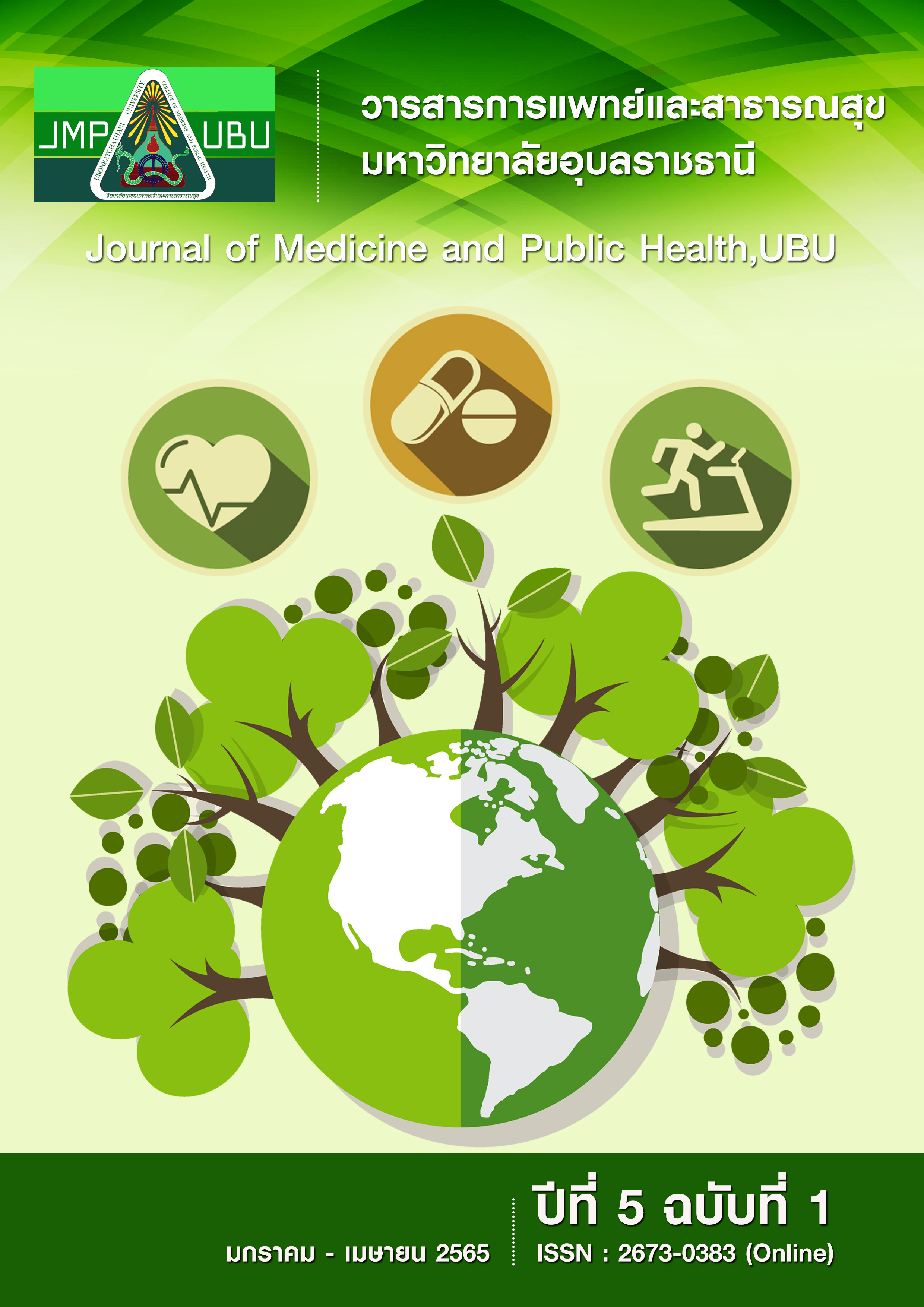ปัจจัยที่มีความสัมพันธ์กับคุณภาพชีวิตของนักศึกษาแพทย์ วิทยาลัยแพทยศาสตร์และการสาธารณสุข มหาวิทยาลัยอุบลราชธานี
คำสำคัญ:
นักศึกษาแพทย์ , คุณภาพชีวิต , ความเครียดบทคัดย่อ
การศึกษาครั้งนี้เป็นการศึกษาเชิงวิเคราะห์แบบภาคตัดขวาง มีวัตถุประสงค์เพื่อศึกษาปัจจัยที่มีความสัมพันธ์กับคุณภาพชีวิตของนักศึกษาแพทย์ วิทยาลัยแพทยศาสตร์และการสาธารณสุข มหาวิทยาลัยอุบลราชธานี ประชากรที่ใช้ในการศึกษาคือ นักศึกษาแพทย์ ชั้นปีที่ 1-6 วิทยาลัยแพทยศาสตร์และการสาธารณสุข มหาวิทยาลัยอุบลราชธานี ปีการศึกษา 2557 จำนวน 179 คน รวบรวมข้อมูลโดยแบบสอบถาม วิเคราะห์ข้อมูลโดยใช้สถิติเชิงพรรณนาและการวิเคราะห์ถดถอยพหุคูณ (Multiple linear regression) ด้วยเทคนิคการวิเคราะห์แบบขจัดออกทีละตัวแปร กำหนดนัยสำคัญ ที่ 0.05 ผลการศึกษาพบว่า นักศึกษาแพทย์มีระดับความเครียดสูงมากที่สุด ร้อยละ 52.51 ระดับคุณภาพชีวิตโดยรวมอยู่ในคุณภาพชีวิตกลางๆ ร้อยละ 71.51 ปัจจัยที่มีความสัมพันธ์กับคุณภาพชีวิตของนักศึกษาแพทย์ วิทยาลัยแพทยศาสตร์และการสาธารณสุข มหาวิทยาลัยอุบลราชธานี อย่างมีนัยสำคัญทางสถิติ ได้แก่ การตัดสินใจเลือกเรียนแพทย์ และ ความเครียด (R2 = 0.302, R2adj = 0.286, p-value < 0.001) ดังนั้นทางวิทยาลัยฯ ควรจัดให้มีการอบรมให้ความรู้เกี่ยวกับวิธีการจัดการความเครียด วิธีการปรับตัว หน้าที่ความรับผิดชอบ แก่นักศึกษาแพทย์ชั้นคลินิก ก่อนที่จะขึ้นปฏิบัติงานจริง เพื่อให้นักศึกษาได้ผ่อนคลายจากความเครียด
Downloads
เอกสารอ้างอิง
Murphy B, Herrman H, Hawthorne G, Pinzone T, Evert H. Australian WHOQoL instruments: User’s manual and interpretation guide. Melbourne, Australia: Australian WHOQoL Field Study Centre; 2000. 59.
Aramrat A. Final report: health promotion medical school 2nd. Chiangmai, Thailand: Consortium of Thai Medical Schools; 2005.
World Health Organization (WHO). Investing in mental health. Geneva, Switzerland: Nove Impression; 2003. 48.
วินิทรา นวลละออง.ปัจจัยที่สัมพันธ์กับคุณภาพชีวิตของนักศึกษาแพทย์ชั้นปีที่ 1. วารสารสมาคมจิตแพทย์แห่งประเทศไทย. 2555; 2: 225-234.
สุวิจักขณ์ อุ่นทวีทรัพย์, เตียววนากุล, วรัทยา โสมภีร์, ไชยวัฒน์ เทียนเครือ. ความชุกและปัจจัยที่มีความสัมพันธ์กับความเครียด ของนักศึกษาแพทย์ศูนย์แพทยศาสตรศึกษา ชั้นคลินิก โรงพยาบาลราชบุรี. วารสารสมาคมจิตแพทย์แห่งประเทศไทย. 2564; 2: 159-172.
สุวัฒน์ มหัตนิรันดร์กุล, วนิดา พุ่มไพศาลชัย, พิมพ์มาศตาปัญญา. การสร้างแบบวัดความเครียดสวนปรุง. วารสารสวนปรุง. 2540; 3: 1-20.
สุวัฒน์ มหัตนิรันดร์กุล, วิระวรรณ ตันติพิวัฒนสกุล, วนิดา พุ่มไพศาลชัย. เครื่องชี้วัดคุณภาพชีวิตขององค์การอนามัยโลกชุดย่อ ฉบับภาษาไทย (WHOQOL – BREF – THAI). โรงพยาบาลสวนปรุง จังหวัดเชียงใหม่; 2540.
ชัยวัชร์ อภิวาทนสิริ, กฤติยา โสมะเกษตรินทร์, กิตติ ศักดิ์ สุรประยูร, ไกรวุฒิ เลื่อมประเสริฐ, นุชวดี วันแก้ว, ภากรณ์ หอมจำปา และคณะ. ความเครียด และ การจัดการความเครียด ของนักศึกษาแพทย์ชั้นคลินิก มหาวิทยาลัยขอนแก่น. ศรีนครินทร์เวชสาร. 2550; (4):416-424.
Helmer KF, Danoff D, Steinert Y, Leyton M, Young SN. Stress and depressed mood in medical students, law students, and graduate students at McGill university. Academic medicine.1997; (8): 708-714.
รุ่งรัตน์ ระย้าแก้ว, วัลลี สัตยาศัย. ความเครียดของนิสิตแพทย์ชั้นปีที่ 4-6 กรณีศึกษาศูนย์แพทยศาสตรศึกษา ชั้นคลินิก โรงพยาบาลพุทธชินราช พิษณุโลก. ธรรมศาสตร์เวชสาร 2556; (1):17-23.
กรมสุขภาพจิต. ความเครียดและสุขภาพจิตของคนไทย. กรมสุขภาพจิต กระทรวงสาธารณสุข; 2555.
ดาวน์โหลด
เผยแพร่แล้ว
รูปแบบการอ้างอิง
ฉบับ
ประเภทบทความ
สัญญาอนุญาต
ลิขสิทธิ์ (c) 2022 วารสารการแพทย์และสาธารณสุข มหาวิทยาลัยอุบลราชธานี

อนุญาตภายใต้เงื่อนไข Creative Commons Attribution-NonCommercial-NoDerivatives 4.0 International License.
เนื้อหาและข้อมูลในบทความที่ลงตีพิมพ์ในวารสารการแพทย์และสาธารณสุข มหาวิทยาลัยอุบลราชธานี ถือเป็นข้อคิดเห็นและความรับผิดชอบของผู้เขียนบทความโดยตรง ซึ่งกองบรรณาธิการวารสารไม่จำเป็นต้องเห็นด้วย หรือร่วมรับผิดชอบใด ๆ
บทความ ข้อมูล เนื้อหา รูปภาพ ฯลฯ ที่ได้รับการตีพิมพ์ในวารสารการแพทย์และสาธารณสุข มหาวิทยาลัยอุบลราชธานี ถือเป็นลิขสิทธิ์ของวารสารการแพทย์และสาธารณสุข มหาวิทยาลัยอุบลราชธานี กองบรรณาธิการไม่สงวนสิทธิ์ในการคัดลอกเพื่อการพัฒนางานด้านวิชาการ แต่ต้องได้รับการอ้างอิงที่ถูกต้องเหมาะสม






